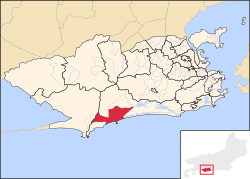This article needs additional citations for verification .(March 2025) |
You can help expand this article with text translated from the corresponding article in Portuguese. (January 2025)Click [show] for important translation instructions.
|
Recreio dos Bandeirantes | |
|---|---|
Neighborhood | |
 | |
 | |
| Coordinates: 23°00′59″S43°28′45″W / 23.01639°S 43.47917°W | |
| Country | |
| State | Rio de Janeiro (RJ) |
| Municipality/City | Rio de Janeiro |
| Zone | Southwest Zone |
Recreio dos Bandeirantes (or simply Recreio) is both the name of a beach and neighborhood in the Southwest Zone of Rio de Janeiro, Brazil. It is a recent development, with no skyscrapers, and the area also contains jungles atop rocky cliffs and hills. High waves permit surfing at Recreio Beach and the white sand beach is used by beach volleyball players. It is about 35 km from the Rio de Janeiro city centre, and most of the people living there are middle-class and high middle-class families, who moved in trying to escape the growing violence of both the North and South Zones.[ citation needed ]
Contents
Apocryphally, the neighborhood received the name Recreio dos Bandeirantes, or "Bandeirantes' Leisure" because the company that mapped and hired a real estate agent to sell lots there had that name.[ citation needed ] Another version says that many of the newcomers were from São Paulo, the city from which the Bandeiras departed in colonial times, and therefore Paulistas are associated with them.[ citation needed ] Still another version states that Recreio was the first (or last) resting place with fresh water for Bandeirantes traveling between Rio de Janeiro and São Paulo.[ citation needed ]

Development in the area began in 1959, and only more recently, have well-to-do residents discovered and made Recreio their home. Despite a high population density, the neighborhood is mostly residential and does not have the busy nightlife of more central neighborhoods like Lapa, Copacabana, Leblon, and Ipanema, but there has been an increase in the number of restaurants, pizzerias, bars, private schools and colleges. There are a few favelas , or slums, in the section. Recreio has an organized association of residents who communicate online with tips and news about the neighborhood. They have been able to address the need for the city building a ciclovia—a road for bicycles—and authorities have been persuaded to build, in the future, two subway stations in the section to facilitate commuting to downtown and the South Side (which would otherwise take about 1.5 h).
